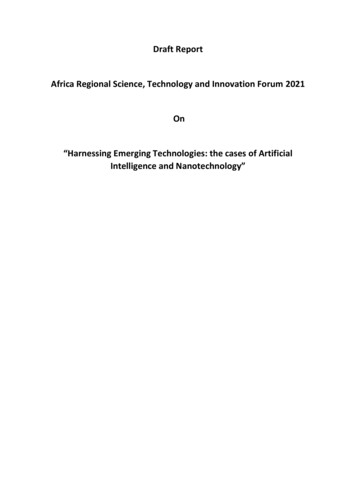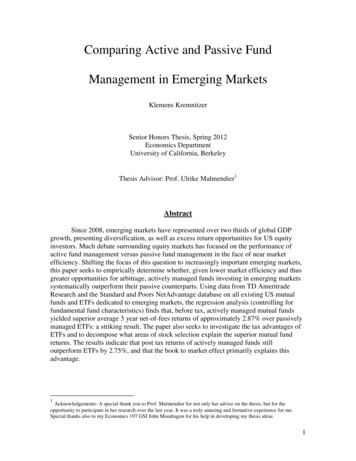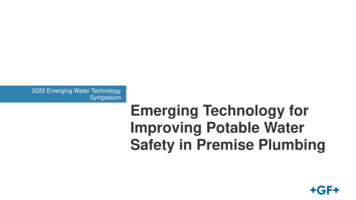
Transcription
PresentationEmerging technologies and the SDGsWorkshop on Science, Technology and Innovation for SDGs29 November – 1 December 2017 Songdo Convensia, Incheon,Republic of KoreaEdward LorenzUniversity of Nice-Sophia Antipolis andMember of University of Côte d’Azur
The SDGs and the Global Challenge The preamble to the UN General Assembly resolution forthe SDGs began with these emotive words:“We recognize that eradicating poverty in all its formsand dimensions, including extreme poverty, is thegreatest global challenge and an indispensablerequirement for sustainable development.”“As we embark on this collective journey, we pledgethat no one will be left behind. (UN GeneralAssembly, 25 September 2015)
Technology and paths to industrialdevelopment in Sub-Sahara Africa (SSA) A large share of Africa’s population risk being leftbehind60% of the world’s extreme poverty ( 1.90/day) (FAO) Extreme poverty concentrated heavily in rural areasamongst populations with high dependence onagriculture including subsistence agriculture.There are no examples of nations that have achievedsustained prosperity and a decent standard of living fortheir citizens without a robust industrial sector
Promises and challenges of emergingtechnologies in Africa: Setting the stage (1) One of the big challenges most African nations face is thatexports of relatively low value added primary productsdominate their intermediate exports. As African nations’participation in global value chains (GVCs) is largely confinedto low value added primary inputs, possibilities for learningand upgrading within GVCs are likely to be limited (McGregoret al. 2016).At the same time, natural resource abundance implies thatagro-industry development provides an important path toindustrialization in Africa. Agro-industry should be widelydefined to include food and beverages, paper and woodproducts, textiles, footwear and apparel, leather products, andrubber products.
Setting the stage (2): micro and small firms .Micro and small firms (MSEs) account for the majorityof non-agricultural employment in Sub-Saharan Africa.They are sources of diversity and complementarity inindustrialization and they provide needed jobopportunities for Africa’s burgeoning youth.Micro and small enterprises have demonstrated theirinnovative potential but they are severely creditconstrained. Africa’s shallow financial systems lack thebreadth to meet the liquidity demand of a large shareof enterprises, and especially those of micro and smallfirms.
Financial constraints on micro and small firmdevelopmentWorld Bank Enterprise Survey: Share of Registered Enterprisesthat are Credit ConstrainedNigeriaMicro and small 20 employees70.3Medium 20-99employees50.3Large .9South Africa40.520.69.9
Setting the stage (3): gaps in infrastructure .Weak and uneven development of infrastructure in energy,transport, and communications contributes directly toAfrica’s low level of productivity and industry’s low and insome cases declining contribution to GDP.Only 30% of Africa’s population has access to electricity,compared to 70-90% in other parts of the developingworld. The road access rate in Africa is only 34%,compared with 50% in other parts of the developingworld, while transport costs are estimated to be 100%higher. Weak infrastructure has been estimated to sloweconomic growth by 2% annually (PIDA, 2012)
How can emerging technologies promoteindustrialization in Africa? There is a need for affordable technologies and scalablesolutions adopted to the needs of small-scale producers bothin agriculture and industry who face big constraints in terms ofaccess to credit and often face daunting infrastructuralchallenges.Emerging technologies can contribute to both agriculturaltransformation and to industrialization through supporting upgrading within local or regional agro-industry value chains.Emerging technologies need to address sustainable solutionsfor infrastructure adapted to the realities of the African setting.Infrastructural development may create spin-off opportunitiesfor skills development and local job creation/entrepreneurshipboth in business services and in manufacturing.
Satellite-based ICT for improved crop production inthe Gezira Irrigation Scheme, Sudan Bottom-up and top-down approach Financed by the Technical Centre for Agricultural and RuralCooperation (CTA) and implementation by the Hydraulic ResearchCentre (HRC) in Sudan44 smallholders (3 to 4 hectares) in pilot projectSatellite imagery in combination with meteorological data andfield assessments to provide irrigation advice assessed viaSMS delivery (no need for smart phones)The pilot farmers experienced an average 60% increase intheir wheat yields, as well as improvements in water-useefficiency.Scalable: Farmers have expressed a willingness to pay forservices which could support their extension to a larger shareof the region’s 140,000 smallholders
ICTs for inclusive agro-industry value chaindevelopment: in search of good practice Dunavant Zambia uses a supply chain management andelectronic payment system that it developed jointly with ITcompany Mobile Transactions Zambia Limited (MTZL) toreduce transaction costs and improve information flowsThroughout its cotton supply chain, from input distribution tocotton gin inventory control Homegrown, a Kenyan agribusiness company with anetwork of more than 1,000 out growers, uses Quick-fire,an audit management software created by ICT companyMuddy Boots to help its out growers meet export marketstandards by ensuring farms supplying the produce areall audited and certified
Biosciences: potential for inclusive value chaindevelopment through science/industry links Bio-resources innovation network is headed up by JuliusEcuru in Nairobi. Aims to exploit radical advances inbiosciences as a basis for innovations for a) value addition toagro produce and creation of agribusiness opportunities, b)agro/biowaste conversion in support of climate changemitigation and environmental sustainability and c)development of policies that foster bioscience innovations inthe region. Development and introduction disease resistant canning beanvarieties in Kenya, Tanzania and Ethiopia in collaboration withthe private bean canning industry Turning factory waste in biogas: pilot facility at Modjo TanneryLtd converting organic elements in wastewater into biogas.
Emerging technologies for sustainable energy:building on transport corridors There are several large-scale renewable energyprojects, (wind and solar) that are designed to extendnational gridsExamples. Lake Turkana, Kenya (310 MW); Tarfaya,Morocco (300 MW); Ashegoda, Ethiopia (120 MW)The existing transport corridors could be used as theskeleton for making extensions to the grids and forgreater regional infrastructural integration (see ECA)There is scope for smart grid technologies given that thenational grids are incomplete to a significant degree.There is opportunity for stage skipping or leapfrogging inthe development of sustainable energy systems.
Renewable energy: bottom-up initiatives Stand alone and mini-grids for renewable solar energy Linked to PAYG mobile money business model forstand alones Growing private market in East African in the area of stand alonesolar energy systems for home and small business useGrowth in private sector entrepreneurship for installation andbusiness servicesStart-ups in East Africa: M-KOPA, Mobisol, Off-GridUnexploited potential for backward linkages intomanufacturing Ubbik East Africa, a joint venture in Kenya for solar panelproduction; SPS located near Accra in Ghana; ARTSolar inDurban, SA
Conclusions: exploiting windows ofopportunity I have highlighted a few areas where disruptive oremerging technologies are creating windows of opportunityfor industrial development in AfricaThere’s a need to develop technologies for up-grading inregional value chain as a basis for the development of anindigenous industrial capacity in agro-industryAttention to the infrastructure/industrialization nexus andfocus on sustainable energy solutions including off-gridsolar and biogas. Forward linkages to knowledge intensive business services(mobile money and finance)Unexploited potential for backward linkages to manufacturingcapacity development
Conclusions: creating windows of opportunity The need for appropriate policies and regulatoryenvironments The need for financial solutions big and small For example standard PPA templates for mini gridsExtend inclusive finance based on mobile money platformsGovernment backing for large scale finance in renewablesincluding manufacturing capacity.The need for greater African regional economicintegration In trade to increase intra-regional trade in support ofregional value chain development.In infrastructureIn mobility of people and talent
Emerging technologies can contribute to both agricultural transformation and to industrialization through supporting up-grading within local or regional agro-industry value chains. Emerging technologies need to address sustainable solutions for infrastructure adapted to the realities of the African setting.










